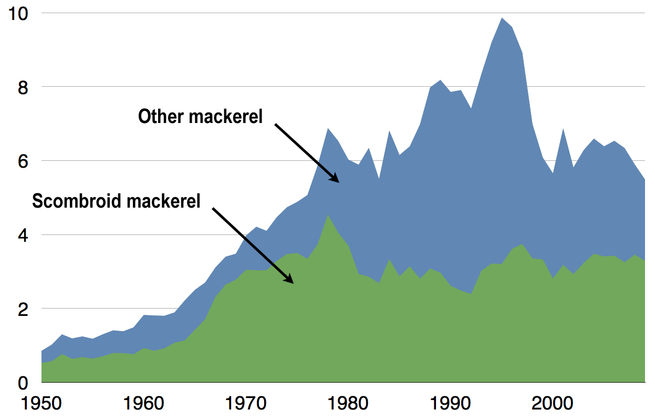
Main Difference
The main difference between Mackerel and Sardine is that the Mackerel is a pelagic fish and Sardine is a common names used to refer to various small, oily fish within the herring family of Clupeidae
-
Mackerel
Mackerel is a common name applied to a number of different species of pelagic fish, mostly from the family Scombridae. They are found in both temperate and tropical seas, mostly living along the coast or offshore in the oceanic environment.
Mackerel species typically have vertical stripes on their backs and deeply forked tails. Many are restricted in their distribution ranges and live in separate populations or fish stocks based on geography. Some stocks migrate in large schools along the coast to suitable spawning grounds, where they spawn in fairly shallow waters. After spawning they return the way they came in smaller schools to suitable feeding grounds, often near an area of upwelling. From there they may move offshore into deeper waters and spend the winter in relative inactivity. Other stocks migrate across oceans.
Smaller mackerel are forage fish for larger predators, including larger mackerel and Atlantic cod. Flocks of seabirds, whales, dolphins, sharks, and schools of larger fish such as tuna and marlin follow mackerel schools and attack them in sophisticated and cooperative ways. Mackerel flesh is high in omega-3 oils and is intensively harvested by humans. In 2009, over 5 million tons were landed by commercial fishermen. Sport fishermen value the fighting abilities of the king mackerel.
-
Sardine
“Sardine” and “pilchard” are common names used to refer to various small, oily fish in the herring family Clupeidae. The term sardine was first used in English during the early 15th century and may come from the Mediterranean island of Sardinia, around which sardines were once abundant.
The terms “sardine” and “pilchard” are not precise, and what is meant depends on the region. The United Kingdom’s Sea Fish Industry Authority, for example, classifies sardines as young pilchards. One criterion suggests fish shorter in length than 15 cm (6 in) are sardines, and larger fish are pilchards. The FAO/WHO Codex standard for canned sardines cites 21 species that may be classed as sardines; FishBase, a comprehensive database of information about fish, calls at least six species “pilchard”, over a dozen just “sardine”, and many more with the two basic names qualified by various adjectives.
-
Mackerel (noun)
An edible fish of the family Scombridae, often speckled.
-
Mackerel (noun)
A pimp; also, a bawd.
-
Sardine (noun)
Any one of several species of small herring which are commonly preserved in olive oil or in tins for food, especially the pilchard, or European sardine ver=161027 (syn. ver=161027). The California sardine ver=161027 (syn. ver=161027) is similar. The American sardines of the Atlantic coast are mostly the young of the Atlantic herring and of the menhaden.
-
Sardine (noun)
carnelian
-
Sardine (noun)
Someone packed or crammed into a small space.
-
Sardine (verb)
to fish for sardines
-
Sardine (verb)
to pack or cram together tightly.
